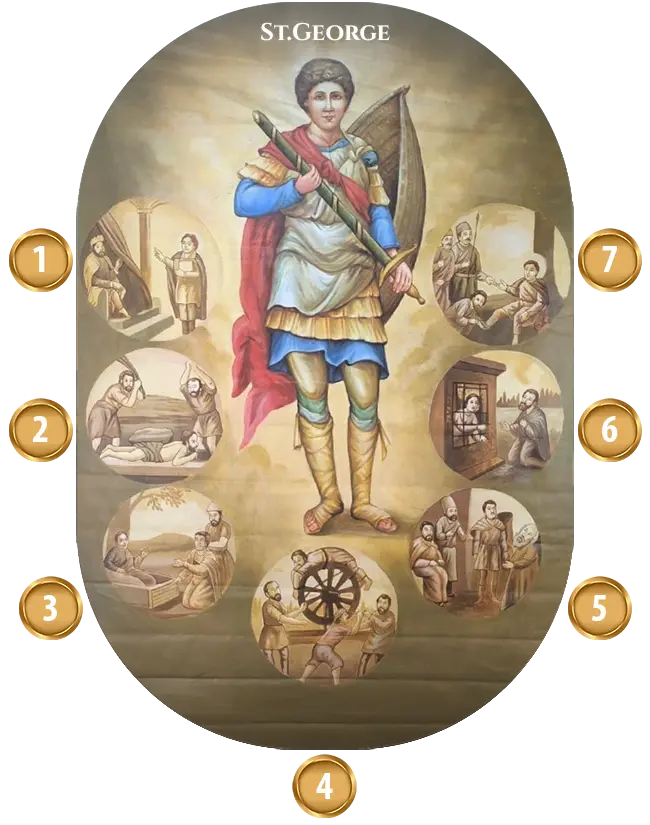St. George
Inside Paintings - South Wall
St. George

Introduction
St. George, one of the most venerated saints in Christendom, was a Roman soldier of noble birth and deep Christian conviction. Born in Cappadocia (modern-day Turkey) into a devout Christian family, he served in the Roman army under Emperor Diocletian. His valour in battle was matched by his unwavering loyalty to Christ.
Persecution and Martyrdom
During the great persecution of Christians under Diocletian, St. George boldly proclaimed his faith and refused to offer sacrifices to pagan gods. His confession enraged the emperor, leading to a series of brutal tortures. The icon you shared depicts these harrowing moments:


1. Enduring Beatings and Scourging
Historical reference: Hagiographic traditions like the Passio Sancti Georgii, the Golden Legend by Jacobus de Voragine
Description: St. George, a soldier of Christian faith, was likely born in Cappadocia (modern-day Turkey) around the late 3rd century to a Christian family. He lived during a time of relentless persecution under Emperor Diocletian, who ruled from 284 to 305 AD and is known for one of the most intense persecutions of Christians in the Roman Empire.
His steadfast refusal to renounce his beliefs led to his brutal arrest and subsequent torture around 303 AD. The torture he endured wasn’t just physical; it was a battle of wills designed to crush his spirit. Initially, George was subjected to merciless beatings, where he was tied to a viciously designed wheel embedded with spikes, leaving his body bloodied and broken.
Every strike he received was intended to both humiliate and compel him to forsake his faith. Yet, the stronger the pain grew, the deeper his faith seemed to root itself. Following these horrific beatings, his suffering continued with brutal scourging; iron rods and whips would tear at his skin, leaving behind agonizing wounds.
In the tales that arose around his martyrdom, it is told that he supernaturally survived these horrors, exhibiting a strength that seemed to defy human endurance. The images of him, enduring these unimaginable torments yet appearing untouched, resonated deeply within the heart of believers, serving as a powerful testament to his unyielding faith. These stories, powerful in nature, highlight not just his physical suffering but also his extraordinary courage in standing firm against overwhelming odds.
2. Torn with Iron Hooks
Historical reference: Hagiographic traditions like the Passio Sancti Georgii, the Golden Legend by Jacobus de Voragine.
Description: St. George, a devout Christian and Roman soldier, faced brutal martyrdom during Diocletian’s vicious persecution of Christians around 303 AD.
George was subjected to severe torments for refusing to renounce Christianity.
Specifically, the torture with iron hooks involved the use of sharp, metal instruments to tear at his flesh. According to tradition, George was either bound or stretched out, and the hooks were used to rip his body, causing excruciating pain. This method was typical of Roman persecution tactics, designed to prolong suffering and serve as a public deterrent. Some accounts embellish the story with miraculous elements, such as George enduring the torture without faltering or being divinely healed, emphasizing his sanctity and resilience.
These details are largely drawn from medieval hagiographies, which aimed to inspire faith.
3. Enduring the Rack
Historical reference: Hagiographic accounts, such as the Golden Legend and the Passio Sancti Georgii
Description: Among the torments described in, being racked is mentioned as part of his martyrdom.
The rack was a brutal torture device used in Roman times, where the victim’s limbs were bound to a frame and stretched, often to the point of dislocation or severe injury, to inflict extreme pain and coerce recantation. In George’s case, some accounts describe him being stretched on the rack as part of his refusal to renounce his Christian faith. These narratives often include miraculous elements, such as divine intervention sustaining him through the ordeal, highlighting his steadfastness.
These incidents paint George as a towering figure of defiance against persecution. His body, racked and torn, became a testament to his unyielding devotion. Miraculously, George endured these horrors with divine strength, sometimes emerging unscathed or restored by God’s grace. His steadfastness under such gruesome trials cemented his legacy as a martyr and patron saint.
4. Wheel of Torture
Historical reference: Hagiographic accounts, such as the Golden Legend and the Passio Sancti Georgii
Description: This method, often referred to as the “wheel of torture” or “breaking wheel,” was a brutal form of punishment in some ancient traditions. Saint George was bound to a large wheel with ropes, and sharp implements—described as swords or blades—were positioned beneath or around the wheel to cut and tear his body as it turned. The intent was to inflict maximum pain and suffering to force him to renounce Christianity.
5. Dragon Slaying
Historical reference: Christian writings & traditions.
Description: A town terrorized by a dragon that lives in a nearby pond. The townspeople first offer the dragon livestock to appease it, but eventually run out of animals. They then resort to a lottery to choose one of their children to sacrifice to the dragon each day. One day, the lot falls upon the king’s daughter, the princess. As the princess is led to the dragon’s cave, Saint George arrives and intervenes. Saint George battles and slays the dragon. In exchange for saving the princess and town, Saint George demands that the townspeople accept Christianity. They agree, and the dragon’s defeat leads to their mass baptism.
The legend of Saint George and the Dragon became a powerful symbol in Christianity, with the image of the mounted knight slaying the dragon seen since the 7th century as a metaphor for a defender against evil. Saint George is venerated as a patron saint in England, where he is celebrated as a national hero.
6. Imprisonment
Historical reference: Hagiographic accounts, such as the Golden Legend and the Passio Sancti Georgii
Description: After surviving the various tortures—often with miraculous interventions that showcased his divine protection—George was thrown into a prison or dungeon. Imprisonment served both as a means to isolate him and as a prelude to his final execution, typically by beheading. The imprisonment phase is often depicted as a time when George continued to demonstrate his faith, sometimes converting others, such as fellow prisoners or even guards, through his resilience and miracles attributed to him.
7. Martyrdom
Historical reference: Historical accounts like Eusebius’ Ecclesiastical History
Description: St. George, a Christian martyr, was beheaded on April 23, 303, in Lydda (modern-day Lod, Israel) under the Roman Emperor Diocletian’s persecution of Christians. As a Roman soldier of Cappadocian Greek origin, George refused to renounce his faith, leading to his arrest, torture, and execution by decapitation. Historical accounts suggest he was a high-ranking officer who boldly opposed Diocletian’s edict to suppress Christianity, possibly by tearing down a public decree. He faced severe torture, including laceration on a wheel of swords, but refused to recant. Ultimately, he was executed by beheading.
His execution inspired many, including Empress Alexandra, to convert to Christianity. St. George became a revered figure, recognized as the patron saint of England, soldiers, and several other regions and groups.
Each torment failed to shake his resolve. Through it all, George displayed peace, prayer, and even brought others to faith through his witness—some of his torturers themselves were converted. His martyrdom stands as a powerful testimony to the victory of spiritual endurance over worldly powers.







